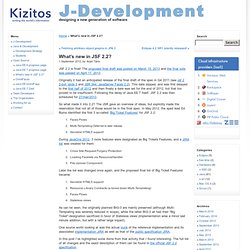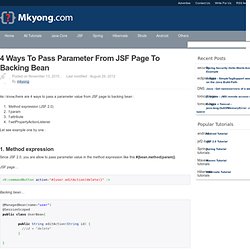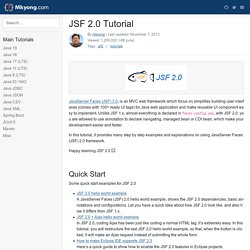

Java Unified Expression Language. What’s new in JSF 2.2? JSF 2.2 is final!

The proposed final draft was posted on March 15, 2013 and the final vote was passed on April 17, 2013. Originally it had an anticipated release of the final draft of the spec in Q4 2011 (see Jsf 2 2-bof, slide 3 and JSR 344: JavaServer Faces 2.2). This date slipped, and was first delayed to the first half of 2012 and then finally a date was set for the end of 2012, but that too proved to be insufficient. Following the delay of Java EE 7 itself, JSF 2.2 was then scheduled for 27/mar/2013. So what made it into 2.2? Faces FlowsMulti-Templating Deferred to later releaseSensible HTML5 support During JavaOne 2012, 3 more features were designated as Big Tickets Features, and a JIRA list was created for them: Cross Site Request Forgery ProtectionLoading Facelets via ResourceHandlerFile Upload Component Later the list was changed once again, and the proposed final list of Big Ticket Features became: Download Latest 2.2 snapshot: implementation jar, source jar. 4 ways to pass parameter from JSF page to backing bean.
As i know,there are 4 ways to pass a parameter value from JSF page to backing bean : Method expression (JSF 2.0)f:paramf:attributef:setPropertyActionListener Let see example one by one : 1.

Method expression Since JSF 2.0, you are allow to pass parameter value in the method expression like this #{bean.method(param)}. JSF page… Backing bean… @ManagedBean(name="user") @SessionScoped public class UserBean{ public String editAction(String id) { //id = "delete" } } Jsf 2.0 - how to handle session expiration in JSF 2.0. JavaServer Faces API (2.0) JSF 2.0 Page Decraration Language: Facelets Variant. JSF 2.0 Tutorials. JavaServer Faces (JSF) 2.0, is an MVC web framework which focus on simplifies building user interfaces (comes with 100+ ready UI tags) for Java web application and make reusable UI component easy to implement.

Unlike JSF 1.x, almost everything is declared in faces-config.xml, with JSF 2.0, you are allowed to use annotation to declare navigating, managed bean or CDI bean, which make your development easier and faster. In this tutorial, it provides many step by step examples and explanations on using JavaServer Faces (JSF) 2.0 framework. Happy learning JSF 2.0 :) Quick Start Some quick start examples for JSF 2.0 JSF 2.0 hello world example A JavaServer Faces (JSF) 2.0 hello world example, shows the JSF 2.0 dependencies, basic annotations and configurations. Managed Bean About managed bean configuration and injection in JSF 2.0 Configure Managed Beans in JSF 2.0 In JSF 2.0, Java bean that can be accessed from JSF page is called Managed Bean.
Navigation How the navigation works in JSF 2.0 Reference. PrimeFaces. API 3.5. VDL 3.5. ShowCase. Blog.primefaces. Cagatay Civici's Weblog. MigrationGuide. This is the migration guide to different PrimeFaces versions.

Feel free to drop a comment to add any missing points. Please note that this is not a changelog as it only lists changes that may cause backward compatibility issues in your applications. Component Changes MenuModel is rewritten and not backward compatible with the old version. DataTable sortBy and filterBy expressions require the plain property name meaning "name" instead of "#{person.name}". General Changes Preferred way of accessing widgets is via PF('widgetVarName').show(), old way (e.g. widgetVarName.show()) is still supported and will be removed in a future version.
DateSelectEvent, ScheduleDateSelectEvent, ScheduleEntrySelectEvnets classes are removed, use SelectEvent instead. IE7 support is phased out. Tree components dom structure has been reimplemented, if you have overwritten trees look and feel, check for compatibility issues. PartialSubmit is now false by default. Component Referencing Theming Form Elements -> -> Issues Tracker. PrimeFaces Extensions. PrimeFaces Extensions - ShowCase. OmniFaces.